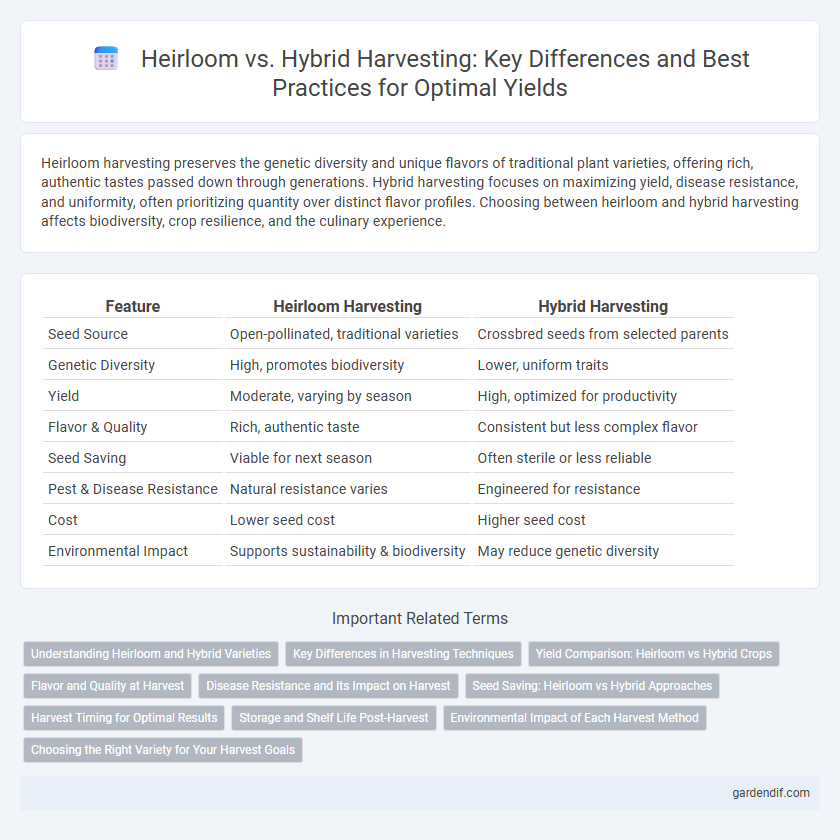
Heirloom Harvesting vs Hybrid Harvesting Illustration
Heirloom harvesting preserves the genetic diversity and unique flavors of traditional plant varieties, offering rich, authentic tastes passed down through generations. Hybrid harvesting focuses on maximizing yield, disease resistance, and uniformity, often prioritizing quantity over distinct flavor profiles. Choosing between heirloom and hybrid harvesting affects biodiversity, crop resilience, and the culinary experience.
Table of Comparison
| Feature | Heirloom Harvesting | Hybrid Harvesting |
|---|---|---|
| Seed Source | Open-pollinated, traditional varieties | Crossbred seeds from selected parents |
| Genetic Diversity | High, promotes biodiversity | Lower, uniform traits |
| Yield | Moderate, varying by season | High, optimized for productivity |
| Flavor & Quality | Rich, authentic taste | Consistent but less complex flavor |
| Seed Saving | Viable for next season | Often sterile or less reliable |
| Pest & Disease Resistance | Natural resistance varies | Engineered for resistance |
| Cost | Lower seed cost | Higher seed cost |
| Environmental Impact | Supports sustainability & biodiversity | May reduce genetic diversity |
Understanding Heirloom and Hybrid Varieties
Heirloom harvesting involves cultivating plant varieties passed down through generations, prized for their unique flavors, genetic diversity, and adaptability to local conditions, which enhances biodiversity in sustainable agriculture. Hybrid harvesting focuses on plants bred from two different parent varieties, designed to maximize yield, disease resistance, and uniformity, often favoring commercial production efficiency. Understanding the distinct genetic traits of heirloom and hybrid varieties allows farmers to select crops that best meet their goals for quality, resilience, and market demand.
Key Differences in Harvesting Techniques
Heirloom harvesting involves traditional techniques aimed at preserving the plant's natural genetic traits, often requiring handpicking and selective gathering to maintain seed purity and flavor profiles. Hybrid harvesting uses mechanized methods tailored to maximize yield and uniformity, with a focus on efficiency and scale rather than genetic preservation. Key differences include the attention to seed conservation and plant diversity in heirloom harvesting versus the productivity-oriented, standardized approach of hybrid harvesting.
Yield Comparison: Heirloom vs Hybrid Crops
Heirloom crops generally produce lower yields compared to hybrid crops due to their traditional genetic makeup and adaptation to specific local conditions. Hybrid harvesting often results in significantly higher yields, benefiting from enhanced disease resistance, uniform growth, and increased productivity. Yield comparison data shows hybrid varieties can outperform heirlooms by 20-50%, making hybrids preferable for maximizing agricultural output.
Flavor and Quality at Harvest
Heirloom harvesting preserves the rich, authentic flavors and superior quality of traditional crop varieties, maintaining their unique taste profiles and nutritional value at harvest. Hybrid harvesting often aims for higher yield and durability but may compromise flavor complexity and texture compared to heirloom varieties. Choosing heirloom crops ensures a more flavorful and aromatic harvest, favored by chefs and food enthusiasts seeking premium quality.
Disease Resistance and Its Impact on Harvest
Heirloom harvesting relies on traditional seed varieties that often have limited disease resistance, making crops more vulnerable to common pathogens and potentially reducing yield quality and quantity. Hybrid harvesting utilizes genetically bred seeds designed for enhanced disease resistance, which helps protect crops from fungal, bacterial, and viral infections, leading to more consistent and higher yields. The improved disease resistance in hybrids significantly reduces crop losses and increases overall harvest reliability compared to heirloom varieties.
Seed Saving: Heirloom vs Hybrid Approaches
Heirloom harvesting emphasizes seed saving by preserving open-pollinated seeds that remain true to type, ensuring genetic diversity and heritage traits for future planting. Hybrid harvesting, however, produces seeds that often fail to replicate the parent plants' characteristics due to cross-breeding, requiring growers to purchase new seeds each season. This distinction affects sustainability and long-term seed sovereignty in agricultural practices.
Harvest Timing for Optimal Results
Heirloom harvesting requires precise timing to capture peak flavor and maintain seed viability, typically harvesting when fruits are fully mature but before overripening. Hybrid harvesting prioritizes uniformity and mechanical efficiency, often collecting crops at a standardized stage to maximize yield and reduce processing time. Proper harvest timing tailored to each variety enhances quality, shelf life, and overall market value.
Storage and Shelf Life Post-Harvest
Heirloom harvests typically offer shorter shelf life due to their natural, unaltered genetics, making storage more challenging and requiring optimal conditions to maintain freshness. Hybrid harvests, engineered for durability and resistance, often exhibit extended shelf life and improved storage capabilities, reducing post-harvest losses. Proper temperature control and humidity management are critical factors influencing the longevity of both heirloom and hybrid crops during storage.
Environmental Impact of Each Harvest Method
Heirloom harvesting supports biodiversity by preserving traditional plant varieties, reducing the need for chemical inputs and promoting healthier soil ecosystems. Hybrid harvesting often relies on genetically engineered crops designed for higher yields but can contribute to soil degradation, increased pesticide use, and reduced genetic diversity. The environmental impact of heirloom harvesting tends to be lower, fostering sustainable agriculture and resilience against climate change.
Choosing the Right Variety for Your Harvest Goals
Selecting the right variety for your harvest goals depends on understanding the differences between heirloom and hybrid seeds. Heirloom varieties offer rich flavors and genetic diversity, ideal for preserving traditional crops and home gardening. Hybrid seeds provide higher yields and disease resistance, making them suitable for commercial harvesting and large-scale production.
Heirloom Harvesting vs Hybrid Harvesting Infographic

 gardendif.com
gardendif.com